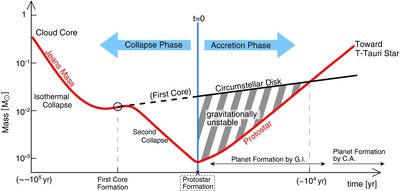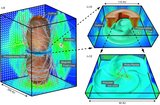Image Details

Caption: Figure 2.
Schematic diagram for the evolution of protostellar objects, in terms of mass. The vertical axis denotes mass (in units of solar mass) and the horizontal axis denotes time (in years). The red curve on the left-hand side depicts the mass of the fast collapsing region in the center of the molecular cloud core in the collapsing phase, which essentially defines the gravitationally unstable mass, and therefore corresponds to the Jeans mass. Note that the mass of the first core is much larger than the mass of the central protostar at its birth. The right-hand side describes the evolution in the main accretion phase, where gas in the envelope of the molecular cloud core accretes onto the central region and the protostar gains its mass. As the first core gradually changes into the protoplanetary disk, the mass of the protoplanetary disk remains larger than the mass of the protostar for a while. This configuration is gravitationally unstable and creates self-gravitating objects in the disk. The protostar mass increases monotonically and overwhelms the mass of the disk later in the accretion phase.
Copyright and Terms & Conditions
© 2010. The American Astronomical Society. All rights reserved.





